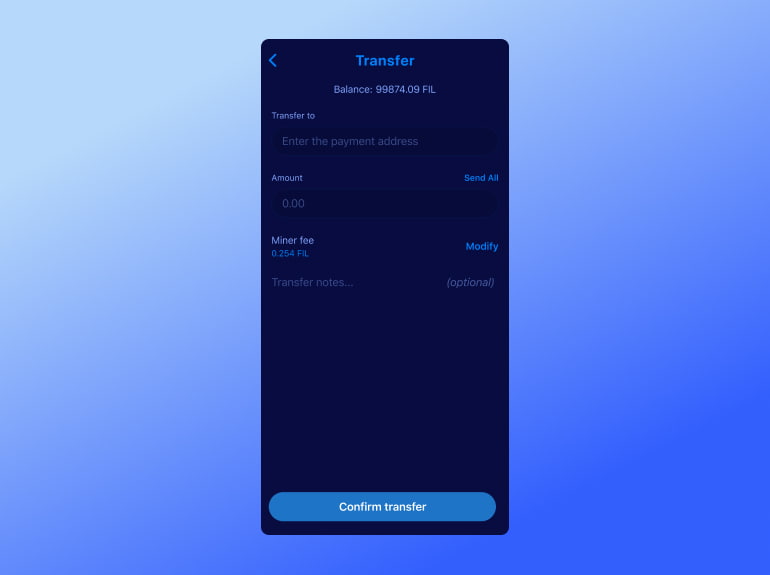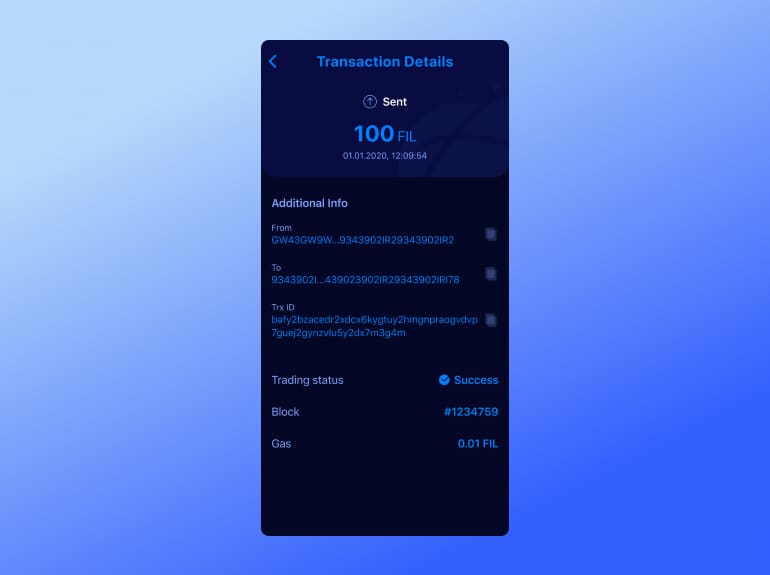
- Home
- Success stories
- FileStar
Project goals
Work done
Design and implementation of an incentive layer for a distributed storage network
Modification of the WindowPoST spot check logic
Introduction of a recursive storage proof to enhance on-chain processing and TPS
Android/ iOS FileStar mobile wallet
Integration of the EVM for smart contract development
Creation of a sustainable and fair token governance system
Technologies used
Business opportunity
FileStar is premised on the idea of Filecoin. The latter is a peer-to-peer network intended for storing files. It incorporates special built-in economic incentives to ensure that files are kept reliably over time.
In spite of its ground-breaking vision and great aspirations, Filecoin does not boast a polished design and sophisticated technical features that could help it demonstrate a greater performance.
On top of that, Filecoin’s project development and management are too centralized and its native token distribution and release are relatively unfriendly to miners. Among other obstacles that prevent it from gaining wider traction are the high threshold for participating in Filecoin mining and a limited on-chain processing capacity.

Solution
Inspired by Filecoin’s innovative idea, our PixelPlex team designed an incentive layer for decentralized storage called FileStar that can help usher in the Web3 internet infrastructure.
The solution is based on the same vision as Filecoin, yet comes with several improvements such as the removal of an initial pledged collateral, integration of the EVM, a more elaborate tokenomics vision, innovative hash algorithms, and much more.
FileStar is also slated to tackle the most pressing challenges of Filecoin and attract more hardware, providing abundant storage, bandwidth, and computation resources.

Details
Taking into account the imperfections of the Filecoin project, our PixelPlex team has worked out and incorporated a set of special features in the FileStar solution. The sophisticated characteristics contribute to FileStar’s high performance, enable incentive at a more refined granular level, and facilitate an optimized utilization of computation, storage, and bandwidth resources.

Innovative hash algorithms


Recursive zk-SNARK technology

Proof of Copy (PoRep) is an essential part of the Filecoin storage proof system: when a miner seals one sector, PoRep requires them to submit two proofs to the network.
However, the on-chain message processing capability (TPS) of the Filecoin network is minimal. When the network becomes congested, proof messages occupy the majority of on-chain resources, and ordinary messages will not be packaged.

FileStar proposes a recursive zk-SNARK technology to reduce the number of messages for submitting proofs, thus solving the TPS problem.
The basic concept of recursive zk-SNARK is that the proof of multiple sectors produced within a certain period will be verified off-chain, generating an aggregate proof. At the end of that period, only one proof needs to be submitted to the network, containing proof of multiple sectors.
The recursive zk-SNARK technology significantly improves the TPS and achieves greater network scaling. By adjusting the number of aggregated proofs, it will adapt the network’s processing capability to meet the needs of different development stages of the FileStar network in the future.
WindowPoST and VRF

In Fileсoin, miners need to provide a Proof of SpaceTime (PoST) upon the completion of the PoRep so as to prove that the data has been continuously stored. If a miner fails to submit Proofs-of-Spacetime to the chain, they will be penalized.
The problem is that as the network grows, the number of WindowPoST submissions will also increase, which will lead to network congestion and affect message processing.

High-performing mining software


Elaborate tokenomics model
To encourage miners to contribute to the storage, computing, and bandwidth of the project, we have designed a FileStar native token called STAR.
STAR can be used for paying for gas and storage and gives its holders the unbreakable right to vote on key decisions and further development of the FileStar project.

Decentralized governance
The FileStar community consists of developers, miners, and average token holders. Each of them can participate in the vote and jointly determine the network’s direction and growth as well as the development and launch of new features.
In the community, anyone has the right to submit a pool request with a complete test code. All submissions will be merged into the test network after a thorough analysis and will be launched on the mainnet once they have demonstrated adequate running.

EVM integration
Our developers have successfully integrated the Ethereum Virtual Machine (EVM) into FileStar. This allows the FileStar team to develop and deploy Ethereum-powered smart contracts right on the platform with minimal changes in the code.

Project features
Lower mining requirements
High scalability
Great data availability
Decentralized governance
Fair token distribution mechanism
Improved performance of mining software
Efficient use of resources
Refined design of the economic model
Ongoing development and future plans
Our PixelPlex team firmly believes that the successful launch of FileStar’s incentive layer for decentralized storage is a significant achievement in the Web3 space.
We continue working on the enhancement of a proof mechanism for computing and bandwidth facilities to further attract different resource providers. This will allow us to create even more robust decentralized computing and distributed bandwidth networks.
As far as long-term goals are concerned, we are planning to:
- enhance the smart contract fucntionality to be able to converge data chunks in more sophisticated storages
- create a desktop application with a convenient interface that will help easily deploy a node and ensure its smooth communication with other nodes
Services
We offer a comprehensive range of services, including IT consulting, custom software development, and specialized expertise in blockchain, machine learning, and data science.
Blockchain Development
Blockchain Development
Smart Contract Development
Web3 Development
Crypto Payment Solutions
Tokenization Services
Protocols
Protocols
Cryptocurrency Exchange Development
Cryptocurrency Development
Top Development Company
Blockchain Consulting
Top Blockchain Consulting Company
Custom Software Development
Mobile App Development
Web Development
Top IT Services Company
IT Consulting
Top Consulting Company
ML Development
Artificial Intelligence Development
Machine Learning Development
Data Science Development
Top BI & Big Data Company
AR & VR Development
AR & VR Development
QA & Software TestingQA & Software Testing Services
UI/UX DesignGive us the pleasure of adding our secret sauce to your app.
We’ll create beautiful screens at the front while breaking the limits of what’s behind them to help your app get to beyond-plausible business achievements.
UI/UX Design Services
MVP DevelopmentValidate your product idea quickly with an MVP—launch faster, test smarter, and refine based on real user feedback.
Leverage our expertise in MVP development to build a scalable, market-ready product with minimal risk and maximum efficiency.
MVP Development Services
Metaverse Consulting & DevelopmentValidate your immersive concept quickly with metaverse development — launch your virtual experience, gather actionable user insights on core features like avatars and social interaction, and iterate based on real-world engagement.
Top Development Company
Solutions
RWA PlatformTokenization makes it easier to trade assets and opens up new investment opportunities and diversifies portfolio.
RWA Platform
Asset tokenization platform development
Arbitrage BotProfit from market inefficiencies with automated, customized trading strategies that boost returns and minimize risk.
Arbitrage Bot
Be a transaction ahead. Catch profit at short notice
CryptoAPIGain an unfair data edge for your dApps. Tap into high-quality blockchain insights to outsmart competitors and fuel smarter decisions.
CryptoAPI
Connect your dApps to blockchain networks in a flash
OTC HawkOffer high-net-worth clients a secure, enterprise-grade trading terminal. Streamline deals, enhance reliability, and optimize top-tier crypto assets.
OTC Hawk
Benefit from our portfolio and wealth management app
DocFlowManage sensitive documents on blockchain. Leverage optional zero-knowledge proofs for trust, privacy, and streamlined workflows.
DocFlow
Intuitive Blockchain-Powered Document Management System
Know-Your-TransactionEnsure every transaction is above board. Monitor digital asset flows for compliance and transparency, supporting both businesses and regulators.
KYT crypto platform
Our KYT platform fosters integrity of financial ecosystems
Industries
We work across a variety of industries, from FinTech to eCommerce, leveraging our accumulated knowledge and best practices to deliver solutions tailored to the unique needs of your business.
FinTech & BankingAs traditional finance goes digital, we are committed to building efficient ecosystems and better engagement.
Think of customized FinTech solutions with tamper-proof transactions and storage, progress transparency and automation — and we’ll make them see the light of day.
$25T
Global Financial Services
20%
Digital/Blockchain Growth
Solutions for FinTech & Banking
Retail & eCommerceWhether you market B2B or B2C, commerce tech trends are all about value-driven purposes, global sustainability, hybrid shopping journeys, and extra-resiliency.
Let your clients know that there’s more to your brand than meets the eye by creating unique customer experiences in all your stores.
$6.3T
Global eCommerce
10-15%
Tech Innovation Growth
Solutions for Retail & eCommerce
Supply Chain & LogisticsTo make things easier for all vendors, we deliver apps for route and cost optimization, vehicle operational support, and better dispatch time efficiency.
With focus is sustainability, resilience, transparency, and immutability, let’s get your transformation going.
$10T
Global Logistics
15-20%
Blockchain Adoption Growth
Solutions for Supply Chain & Logistics
HealthcareCustom healthcare software solutions are aimed at helping you ensure accurate diagnosis, better patient engagement, and positive healthcare outcomes.
Whether you require a patient management solution, practice management software, EMR/EHR system, or ML-enabled diagnostics – we’ve got you covered.
$10T
Global Healthcare
20%
Digital/Blockchain Growth
Solutions for Healthcare
Real EstateKeep up with digital innovation trends by accelerating enterprise transformation and scaling, leveraging data and orchestrating workflows.
Whether you manage and sell commercial facilities or invest third-party capital, our integrated solutions help you make the most of it.
$340T
Global Real Estate
15%
PropTech/Blockchain Growth
Solutions for Real Estate
Oil & GasWith mobility and digital technologies standing to change the game and define leadership, our mission is to get you digital-first.
Resolve operational and conceptual issues by introducing clear tech vision, feasible architectures, and flexible software to take business extension off limits.
$4T
Global Oil & Gas Industry
10-15%
Digital/Blockchain Growth
Solutions for Oil & Gas Industry
InsuranceImagine a world where quoting policies, processing claims, and managing mountains of paperwork are effortless. PixelPlex can help you achieve just that.
Break free from outdated systems and focus on what truly matters – delivering exceptional service to your policyholders and growing your insurance business.
$25T
Global financial services
20%
Digital/blockchain growth
Solutions for Insurance Industry
FitnessWe create custom fitness software solutions that support meaningful training and steady engagement from the first session.
If you’re building a digital product for active users and need a team with real project experience behind it, we’ll help you bring it to life with clarity and purpose.
$257B
Global Fitness Industry
24%
Digital Growth
Solutions for Fitness
Success stories
Domain
Industry
Protocols
Company
About us Team Careers Social Responsibility ContactsBlog
Blockchain Big Data Artificial Intelligence AR/VR Mobile News View Blog